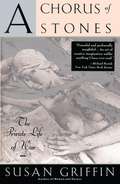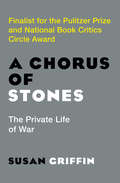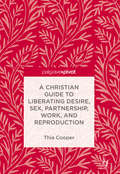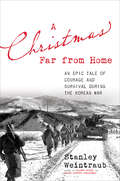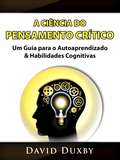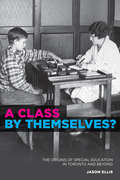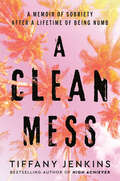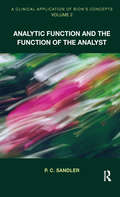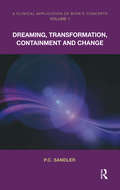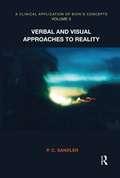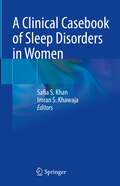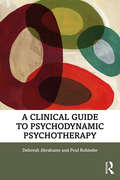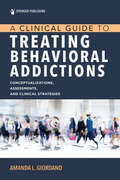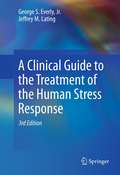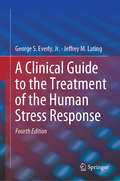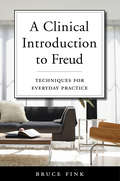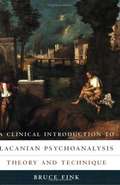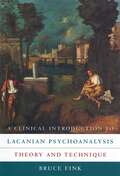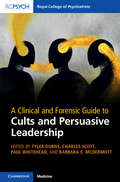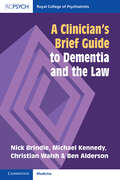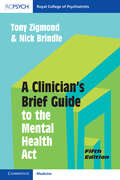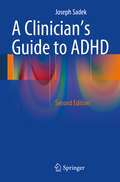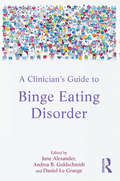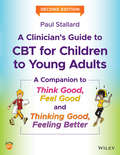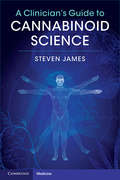- Table View
- List View
A Chorus Of Stones
by Susan GriffinWritten by one of America's most innovative and articulate feminists, this book illustrates how childhood experience, gender and sexuality, private aspirations, and public personae all assume undeniable roles in the causes and effects of war.
A Chorus of Stones: The Private Life of War
by Susan GriffinA brilliant and provocative exploration of the interconnection of private life and the large-scale horrors of war and devastation A Pulitzer Prize and National Book Award finalist, and a winner of the Bay Area Book Reviewers Association Award, Susan Griffin's A Chorus of Stones is an extraordinary reevaluation of history that explores the links between individual lives and catastrophic, world-altering violence. One of the most acclaimed and poetic voices of contemporary American feminism, Griffin delves into the perspective of those whose personal relationships and family histories were profoundly influenced by war and its often secret mechanisms: the bomb-maker and the bombing victim, the soldier and the pacifist, the grand architects who were shaped by personal experience and in turn reshaped the world. Declaring that "each solitary story belongs to a larger story"--and beginning with the brutal and heartbreaking circumstances of her own childhood--Griffin examines how the subtle dynamics of parenthood, childhood, and marriage interweave with the monumental violence of global conflict. She proffers a bold and powerful new understanding of the psychology of war through illuminating glimpses into the personal lives of Ernest Hemingway, Mahatma Gandhi, Heinrich Himmler, British officer Sir Hugh Trenchard, and other historic figures--as well as the munitions workers at Oak Ridge, a survivor of the Hiroshima bombing, and other humbler yet indispensible witnesses to history.
A Christian Guide to Liberating Desire, Sex, Partnership, Work, and Reproduction
by Thia CooperWhat is good sex from the perspective of liberation theology? Thia Cooper argues that sex can be a way to know God. God created humans with a desire to be in relation with each other. From this understanding, sexual desire, sex, and partnerships are re-imagined positively. Good sex is enjoyable and mutual, an aspect of communion. Good sexual relationships share power, empower the participants, and the wider community. From the perspective of liberation theologies and an analysis of biblical texts, the Christian tradition, and the reality of our sexual experience, this book reframes theologies of partnership, sex work, and reproduction through the celebration of desire and sex.
A Christmas Far from Home: An Epic Tale of Courage and Survival during the Korean War
by Stanley WeintraubAn anecdote-rich narrative of the 1950 holiday season during the Korean War, when, just after Thanksgiving, tens of thousands of US troops were surrounded in the Chosin reservoir area by hundreds of thousands of Chinese troops and began a terrible and difficult retreat, which finally ended on Christmas Day.
A Ciência do Pensamento Crítico: Um Guia para o Autoaprendizado & Habilidades Cognitivas
by David DuxbyVocê gostaria de ser capaz de pensar criticamente e com clareza? As técnicas de pensamento crítico já vêm sendo utilizadas há muito tempo para tomar decisões melhores em todos os aspectos da vida, literalmente! Ao usar as técnicas de pensamento crítico, será mais fácil planejar seu orçamento, aumentar sua renda, viver bem, ter uma alimentação mais saudável, tomar melhores decisões, ter mais disposição, foco e satisfação de maneira geral e muito mais! Desenvolva suas habilidades de pensamento crítico e cultive emoções mais positivas e mais qualidade de vida. Este guia apresenta os segredos dos profissionais mais eficientes e como eles usam o pensamento crítico! Após décadas de estratégias testadas, este e-book trará a você a maneira mais rápida e eficiente de usar o pensamento crítico para o seu benefício e bem-estar! Você aprenderá técnicas comprovadas sem precisar investir em cursos caros ou outros materiais complementares. O que você encontrará neste guia: - Tome melhores decisões. - Tenha relações mais saudáveis. - Ganhe mais dinheiro. - Tenha mais energia. - Alimente-se melhor. - Reduza e elimine a ansiedade. - Tenha um sono de melhor qualidade. - Aprenda a lidar com desafios e obstáculos com maior facilidade. E muito mais! Se você quer se tornar mais saudável ou melhorar o seu foco e o seu bem-estar, então este guia é para você.
A Class by Themselves?: The Origins of Special Education in Toronto and Beyond
by Jason EllisIn A Class by Themselves?, Jason Ellis provides an erudite and balanced history of special needs education, an early twentieth century educational innovation that continues to polarize school communities across Canada, the United States, and beyond. Ellis situates the evolution of this educational innovation in its proper historical context to explore the rise of intelligence testing, the decline of child labour and rise of vocational guidance, emerging trends in mental hygiene and child psychology, and the implementation of a new progressive curriculum. At the core of this study are the students. This book is the first to draw deeply on rich archival sources, including 1000 pupil records of young people with learning difficulties, who attended public schools between 1918 and 1945. Ellis uses these records to retell individual stories that illuminate how disability filtered down through the school system’s many nooks and crannies to mark disabled students as different from (and often inferior to) other school children. A Class by Themselves? sheds new light on these and other issues by bringing special education’s curious past to bear on its constantly contested present.
A Clean Mess: A Memoir of Sobriety After a Lifetime of Being Numb
by Tiffany JenkinsThe bestselling author of High Achiever chronicles life after addiction—the raw, the dark, and the hilarious—from setting out with nothing but a backpack to discovering her marriage was built on a shakier foundation than she&’d ever imagined to staying sober when life fell apart.&“Tiffany Jenkins illustrates that recovery is not just about sobriety, but about learning to live and feel again. Her compelling story is a testament to the power of resilience, humor, and hope.&”—Sarah Levy, author of Drinking GamesA Clean Mess opens with the moment that changed everything. Tiffany is about to go on stage when she receives an odd message from her husband: &“Hey Babe, some of the guys here are making some stupid decisions. Not me. But I just wanted to let you know in case you heard it from some of the other wives.&” By the end of the night, Tiffany knew her life would never be the same.This wasn&’t the first time she had to start over. After the opioid addiction and jail sentence that she chronicled in her bestselling memoir, High Achiever, Tiffany was ready for a fresh start. A chance to try life again, this time without drugs coursing through her veins. In A Clean Mess, she takes us back to those early days of recovery, and the whirlwind that she entered the moment she was out of prison. In just two years, she went from inmate to married and sober mom of three. Told with humor and honesty, A Clean Mess is Tiffany Jenkins&’s story of how she learned to live and feel for the first time without numbing herself with drugs—and how she discovered inner reserves of strength she didn&’t know she had. From her tentative first days of sobriety, to seeing two pink lines on a pregnancy test weeks later, to navigating anxiety, a new marriage, and motherhood at the same time, to surviving betrayal and divorce, Jenkins shows how she got through it all when her crutches and Band-Aids were taken away from her. An inspiring memoir that reads like fiction, A Clean Mess is a book that will buoy anyone seeking a life raft in hard times.
A Clinical Application of Bion's Concepts: Analytic Function and the Function of the Analyst
by P.C. SandlerThis book presents the clinical application of Bion's ideas and deals with the author's personal analytic experience, which echoes the experience of other practising analysts. It examines the cultural and historical antecedents, especially including the philosophical and scientific points of view.
A Clinical Application of Bion's Concepts: Dreaming, Transformation, Containment and Change
by P.C. SandlerThis work depicts clinical applications stemming from Dr Wilfred Ruprecht Bion's contributions to psychoanalysis. It may be used as a practical companion to The Language of Bion: A Dictionary of Concepts also by P.C. Sandler. Both constitute a natural arrangement of Bion's concepts; "natural" being the help the selected concepts may provide to any analyst who understands and uses the observations underlying the concepts effectively in his or her everyday clinical work. It also contains expansions of Bion's concepts arising out of clinical observations, made possible by those very contributions - a common-sense invariant in science. Universes of hitherto unknown - but existing - facts are observed, and through observation and application expanding universes are unlocked to consciousness (and therefore awareness). Some chapters will help the reader understand Bion's original concepts and apply them in clinical practice. Other chapters are more explicit and go beyond what was adumbrated or indicated by Bion, in the light of phenomena observed against the background of Bion's contributions. These chapters also indicate the intertwined nature of his contributions.
A Clinical Application of Bion's Concepts: Verbal and Visual Approaches to Reality
by P.C. SandlerThis book presents many correlations which link remarkable theories from Bion with a detailed selection of the author's personal clinical experiences. It demonstrates the real existence of conditions that allow dialogue and clinical investigation by the analytic pair.
A Clinical Casebook of Sleep Disorders in Women
by Imran S. Khawaja Safia S. KhanSleep disorders are very common among women during their lifespan, presenting in isolation or in combination with other illnesses particularly psychiatric and neurologic disorders. Pregnancy-related sleep disorders pose an interesting dilemma as this is a transient phase; these are associated with potential long-term effects on maternal and fetal health. Menopause and pre-menopausal stages lead to a significant change in sleep architecture, sometimes associated with insomnia with or without sleep related breathing disorder. Sleep architecture in men and women varies due to significant hormonal differences between the genders. However, sleep complaints are disproportionately higher among women. This book presents 20 clinical cases to understand the differences in presentation of symptoms and treatment options for various sleep disorders that are more commonly noted among women. These cases cover a spectrum of sleep related breathing disorders, sleep related movement disorders, hypersomnias, parasomnias, issues of sleep fragmentation leading to insomnia in association with hormonal changes and some unique cases encountered in our clinical practices. This compilation of interesting clinical cases presents trainees and experienced physicians with a useful guide to assist in their clinical practices and will stimulate further research and studies.
A Clinical Guide to Psychodynamic Psychotherapy
by Poul Rohleder Deborah AbrahamsA Clinical Guide to Psychodynamic Psychotherapy serves as an accessible and applied introduction to psychodynamic psychotherapy. The book is a resource for psychodynamic psychotherapy that gives helpful and practical guidelines around a range of patient presentations and clinical dilemmas. It focuses on contemporary issues facing psychodynamic psychotherapy practice, including issues around research, neuroscience, mentalising, working with diversity and difference, brief psychotherapy adaptations and the use of social media and technology. The book is underpinned by the psychodynamic competence framework that is implicit in best psychodynamic practice. The book includes a foreword by Prof. Peter Fonagy that outlines the unique features of psychodynamic psychotherapy that make it still so relevant to clinical practice today. The book will be beneficial for students, trainees and qualified clinicians in psychotherapy, psychology, counselling, psychiatry and other allied professions.
A Clinical Guide to Treating Behavioral Addictions
by Amanda L. GiordanoThis practical, approachable guide for clinicians comprehensively covers an array of behavioral addictions ranging from internet gaming addiction and sex addiction, to social media addiction and food addiction. Each chapter answers foundational questions to inform clinical practice including: How do I conceptualize it?, How do I identify it?, How do I assess it?, How do I treat it?, and How do I learn more? &Through this innovative resource, clinicians will gain valuable knowledge regarding the conceptualization, identification, assessment, and treatment of behavioral addictions. <P><P>Each chapter highlights the most current research related to specific behavioral addictions, provides a synthesis of recent neuroscience, and examines diverse treatment approaches to fit the widest range of clinical styles. In addition, this book describes the evolving definition of addiction, provides examples of how to advocate for clients with behavioral addictions, and devotes an entire chapter to understanding the neuroscience of addiction. This clinical reference book will help counselors provide compassionate, effective services to clients with a variety of behavioral addictions. Purchase includes digital access for use on most mobile devices or computers.
A Clinical Guide to the Treatment of the Human Stress Response (Springer Series On Stress And Coping Ser.)
by George S. Everly Jr. Jeffrey M. LatingThis new edition emphasizes the unique contribution of this longstanding text in the integration of mind/body relationships. The concept of stress, as defined and elaborated in Chapter 1, the primary efferent biological mechanisms of the human stress response, as described in Chapter 2, and the link from stress arousal to disease, as defined in Chapter 3, essentially remains the same. However, updates in microanatomy, biochemistry and tomography are added to these chapters. All other chapters will be updated as well, as there has been significant changes in the field over the past eight years.
A Clinical Guide to the Treatment of the Human Stress Response (Springer Series On Stress And Coping Ser.)
by Jeffrey M. Lating George S. Everly, Jr.This comprehensive update of the now classic text applies the most current findings across disciplines to the treatment of pathogenic human stress arousal. New and revised chapters bring together the art and science of intervention, based in up-to-date neuroscience, starting with an innovative model tracing the stress-to-disease continuum throughout the systems of the human body. The authors detail the spectrum of physiological and psychological treatments for the stress response, including cognitive therapy, neuromuscular relaxation, breathing exercises, nutritional interventions, and pharmacotherapy. They also assess the strengths and limitations of widely-used measures of the stress response and consider the value of personality factors, cultural considerations, and resilience in stress mediation.Included in the coverage:The anatomy and physiology of the human stress response.Advances in neuroscience: implications for stress.Crisis intervention and psychological first aid.Neurophysiological rationale for the use of the relaxation response.Physical exercise and the human stress response. The pharmacological management of stress reactions. Disaster Mental Health Planning.Cultural Awareness and Stress.The Fourth Edition of A Clinical Guide to the Treatment of Human Stress Response offers readers a dual perspective, exceedingly useful in examining the origins of the stress response, and in preventing and treating the response itself. This rich integrative volume will join its predecessors in popularity among practitioners and students across disciplines and specialties.
A Clinical Introduction to Freud: Techniques for Everyday Practice
by Bruce FinkFreud’s central theories explained in the context of modern therapy. Often overlooked because he is so easy to mock, ridicule, or just plain misunderstand, Freud introduced many techniques for clinical practice that are still widely employed today. Yet surprisingly, there has never been a clinical introduction to Freud's work that might be of use to students and professionals in their everyday lives and careers. Until now. Bruce Fink, who is his generation's most respected translator of Lacan's work and a profound interpreter of Freud's, has written the definitive clinical introduction to Freud. This book presents Freud in an eminently usable way, providing readers with a plethora of examples from everyday life and clinical practice illustrating the insightfulness and continued applicability of Freud's ideas. The overriding focus is on techniques Freud developed for going directly toward the unconscious, illustrating how we can employ them today and perhaps even improve on them. Fink also lays out many of Freud's fundamental concepts—such as repression, isolation, displacement, anxiety, affect, free association, repetition, obsession, and wish-fulfillment—and situates them in highly applicable clinical contexts. The emphasis throughout is on the myriad techniques developed by Freud that clinicians of all backgrounds and orientations can draw upon to put in their therapy toolbox, whether or not they identify as "Freudians." With references ranging from Star Trek and the Moody Blues to hard drives and unicorns, Bruce Fink's elegant writing brings Freud into sharp focus for clinicians of all backgrounds. To readers who ask with an open mind "Does this approach allow me to see anything that I had not seen before in my clinical work?" this book will offer many new insights.
A Clinical Introduction to Lacanian Psychoanalysis: Theory and Technique
by Bruce Fink"The goal of my teaching has always been, and remains, to train analysts. " --Jacques Lacan, Seminar XI, 209 Arguably the most profound psychoanalytic thinker since Freud, and deeply influential in many fields, Jacques Lacan often seems opaque to those he most wanted to reach. These are the readers Bruce Fink addresses in this clear and practical account of Lacan's highly original approach to therapy. Written by a clinician for clinicians, Fink's Introduction is an invaluable guide to Lacanian psychoanalysis, how it's done, and how it differs from other forms of therapy. While elucidating many of Lacan's theoretical notions, the book does so from the perspective of the practitioner faced with the pressing questions of diagnosis, what therapeutic stance to adopt, how to involve the patient, and how to bring about change. Fink provides a comprehensive overview of Lacanian analysis, explaining the analyst's aims and interventions at each point in the treatment. He uses four case studies to elucidate Lacan's unique structural approach to diagnosis. These cases, taking up both theoretical and clinical issues in Lacan's views of psychosis, perversion, and neurosis, highlight the very different approaches to treatment that different situations demand.
A Clinical Introduction to Lacanian Psychoanalysis: Theory and Technique
by Bruce FinkArguably the most profound psychoanalytic thinker since Freud, and deeply influential in many fields, Jacques Lacan often seems opaque to those he most wanted to reach. These are the readers Bruce Fink addresses in this clear and practical account of Lacan's highly original approach to therapy. Written by a clinician for clinicians, Fink's introduction is an invaluable guide to Lacanian psychoanalysis, how it's done, and how it differs from other forms of therapy. While elucidating many of Lacan's theoretical notions, the book does so from the perspective of the practitioner faced with the pressing questions of diagnosis, which therapeutic stance to adopt, how to involve the patient, and how to bring about change.
A Clinical and Forensic Guide to Cults and Persuasive Leadership
by Charles Scott Paul Whitehead Tyler Durns Barbara McDermottCults have captivated public imagination, gained visibility in the media, and become a popular topic of discourse. While anecdotal and journalistic accounts offer compelling insights, systematic study on the structure, psychological predispositions, and relevance to clinical and legal settings are comparatively scarce. This disparity highlights a crucial need for rigorous scholarly inquiry, moving beyond media portrayals to uncover the foundational mechanisms that sustain and shape these enigmatic groups. Authored by experts in forensic psychiatry and psychology, this book consolidates the extant literature in reviewing the theoretical, sociocultural, clinical, and forensic issues surrounding cultist groups. This text applies evidence-based study to identify group subtypes and explore mediators and moderators that may be relevant in clinical and legal contexts. Authors address issues as they relate to a variety of subpopulations, comorbid mental disorders, mind-altering substances, treatment, and the and legal implications inherent to cults and persuasive leadership. This book may be especially pertinent to mental health professionals and those working in the criminal justice system.
A Clinician's Brief Guide to Dementia and the Law
by Michael Kennedy Nick Brindle Christian Walsh Ben AldersonDementia is a topic of enormous medical, legal and ethical importance with considerable human and economic cost. Its importance grows with the change in demographics of the aging population and that people with dementia receive care in a wide range of settings. The legal and ethical problems raised in treating patients with dementia are diverse and complex and are dealt with by many practitioners on a daily basis. This book is a 'how-to' guide to understanding how the law applies to people with dementia, from diagnosis through to end-of-life. It explores the practical problems that people experience, and practitioners face, giving an accurate account of statute, court cases and other inquiries, to give readers an up-to-date account of the law and how it applies in this area. An essential read for clinicians and practitioners that work with patients with dementia, including psychiatrists, primary care physicians, nurses, social workers and advocates.
A Clinician's Brief Guide to the Mental Health Act (A Clinician's Brief Guide)
by Tony Zigmond Nick BrindleA 'how to' book guiding clinicians through the mental health legislation that they need to understand and use in their daily practice, covering the Mental Health Act 1983 and subsequent amendments. This revised and updated edition incorporates new acts, such as the Policing and Crime Act 2017 and Mental Capacity (Amendment) Act 2019. It also covers the findings and implications from Professor Sir Simon Wessely's 2018 review of the Mental Health Act in a new chapter. Written by two leading psychiatrists with many years of experience in using the mental health legislation and in running mental health law courses, this book outlines how changes to statutes and case law have a direct bearing on day-to-day psychiatric practice and why it is important that clinicians of all disciplines have access to and understand the legislation. This is the go-to guide for all clinicians, doctors and nurses working in mental health services.
A Clinician's Guide to ADHD
by Joseph SadekThe Clinician's Guide to ADHD combines the useful diagnostic and treatment approaches advocated in different guidelines with insights from other sources, including recent literature reviews and web resources. The aim is to provide clinicians with clear, concise, and reliable advice on how to approach this complex disorder. The guidelines referred to in compiling the book derive from authoritative sources in different regions of the world, including the United States, Canada, Australia, and Europe. After introductory discussion of epidemiology and etiology, guidance is provided on diagnosis in different age groups, differential diagnosis, assessment for potential comorbidities, and the issue of ADHD and driving. Advice is then given on the appropriate use of pharmacological and psychosocial treatment, the management of adverse events, and follow-up. A series of relevant scales, questionnaires, and websites are also included.
A Clinician's Guide to Binge Eating Disorder
by Daniel Le Grange June Alexander Andrea B. GoldschmidtIncidence of BED appears to be on the increase. Treating it, and overcoming it, is all the more difficult, especially for those living in a culture that has an intense body image focus. A Clinician’s Guide to Binge Eating Disorder educates the reader about its triggers and behaviours – and describes steps to treat it and resume a full and productive life. Evidence-based research outcomes provide the framework and foundation for this book. First-person case studies bring application of this science to life to help close the gap between research and treatment/care, and the importance of clinicians developing a therapeutic relationship as a healing tool with their client is discussed, recognizing that medical and psychological dimensions are inextricably intertwined. This book allays fear of the unknown, explains the emotional chaos that can sweep in like a storm when, unintentionally, triggers are released. It provides practical steps and footholds for clinicians and researchers to help the patient take control of their life and look to a positive future.
A Clinician's Guide to CBT for Children to Young Adults: A Companion to Think Good, Feel Good and Thinking Good, Feeling Better
by Paul StallardA powerful and insightful clinical resource for CBT practitioners who work with children and young adults The newly updated and thoroughly revised Second Edition of this companion to Think Good, Feel Good and Thinking Good, Feeling Better delivers guidance for clinicians using the author’s seminal workbooks. This companion work builds upon the workbook materials by offering readers instruction on all aspects of the therapeutic process and a wide range of case studies highlighting specific therapies in action. A Clinician’s Guide covers topics including parental involvement, key cognitive distortions in children, formulations, challenging thoughts, guided discovery, and the use of imagery. The author also includes a chapter focusing on common potential problems that arise in therapy and strategies to overcome them. The book highlights the underlying philosophy, process, and core skills of employing CBT with children and young people. Readers will appreciate the competency framework, which describes the CORE philosophy, PRECISE process, and the ABCs of specific techniques. The book also includes: Additional materials and handouts for use in therapy, including psycho-educational materials for children and parents on common problems, like depression, OCD, PTSD, and anxiety Downloadable, multi-use worksheets for use in the clinician’s therapeutic sessions Practical, real-world case examples that shed light on the techniques and strategies discussed in the book A systematic approach to the use of cognitive behavioural therapy to treat common psychological problems Perfect for professionals and trainees in child and adolescent mental health, like psychiatrists, clinical psychologists, educational psychologists, community psychiatric nurses, and occupational therapists, the book also belongs on the shelves of non-mental health professionals, including school nurses and social workers, who regularly work with children in a therapeutic setting.
A Clinician's Guide to Cannabinoid Science
by Steven JamesMedical marijuana and the promise of medical advances with cannabinoids is a controversial topic. This book provides clinicians with credible, peer-reviewed science to advise patients on the use of cannabinoids in practice. From the history of cannabis to the recent discoveries, chapters include the science of cannabinoids, changes in the legal and regulatory landscape, and the emerging area of endocannabinoids. The book differentiates approved cannabinoids from cannabis and medical marijuana and stimulates clinicians to think about the risks and benefits of these two drugs. It provides the factual background for clinicians to lead the discussion on the continued use of marijuana, ongoing areas of research and future advances and development of new medications for treatment. An invaluable guide for all specialists in the pharmaceutical sciences, toxicologists, biochemists, neurologists, psychiatrists, addiction specialists, as well as primary care physicians, nurse practitioners, and regulators and policymakers.
